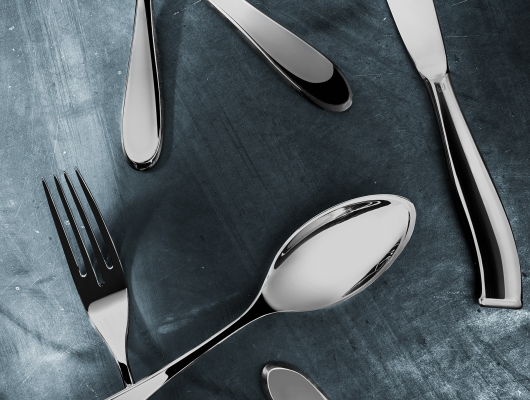Fish knife, Carmen collection by La Tavola
After smartphones, keyboards, soaps and grips, flatware is certainly among the top 10 items we use the most on a daily basis.
It became an extension of our own body, an item that we hold and employ so naturally that we hardly ever pay attention to it anymore; growing up involves becoming acquainted with a series of gestures that gradually evolve till becoming habits that we struggle to recognize so. Fast backward: remember that kind of eagerness that turned every common object into an extraordinary discovery?
Wonder who brought us such widespread yet timelessly glorious tools called flatware?

London, 1851, The Great Exhibition - (ph. credits vam.ac.uk)
According to the records, the word flatware originated back towards the end of the 19th century; the overall term, though, includes knives, that are classified as cutlery. In fact, the world's first printed appearance dates back to 1851 in the official Great Exhibition catalog, that is, the first in a series of World’s Fairs that celebrated the Works of Industry of All Nations.
The fair, attended by six million people including Charles Darwin and Dickens, was held in the Crystal Palace in Hyde Park, London, a building specifically designed to hold the event; 25 countries exhibited their products, including the world’s first voting machine, several shapes and dimensions of the rarest and purest diamonds, an achromatic telescope and of course, flatware.

London 1851, The Great Exhibition - (ph. credits: mashable.com)
Precisely, the term referred to dishes rather than cutlery; plates, dishes and saucers took the name flatware only in the mid-19th century so as to be distinguished from holloware items, the earliest term used to classify bowls, pans, pots, cups and other metal vessels with depth.

Premiere collection by La Tavola, Retrò finish
The very first eating tools were carved from bones and stones; later on, shells, wood and eventually metal including steel, iron and bronze made their way to the shaping of such utensils. Although spoon is the oldest eating items ever made, forks are those who experienced the most changes over the centuries.
It is thanks to the Romans if we now have forks with two prongs; in fact, in the middle ages, those were used as serving items, eventually developing into smaller pieces for the sake of ease and spread of usage. It is said that forks were first introduced on a table during the 11th century by hand of a Byzantine princess in Venice. On the other hand, knives are to be considered the very first eating utensil being ever invented, due to their employment in hunting-related activities.

(ph. credits queensofsienna.com)
Precious or semi-precious materials were employed to craft the handle which during the centuries underwent quite a transformation: from being spiked-shaped in order to extract snails from shells, to gem-encrusted decorations, that specific part of the cutlery is the one most suitable to customization.
The 18th-century society would typically identify silverware with wealthy women of the highest classes, thus moneyed families would have their initials carved on the handle. The use of silver for the making of eating utensils was launched by the Romans; ever since, are considered silverware all those items made of sterling silver 925 parts silver to 75 parts of another metal, usually copper.

Premiere collection by La Tavola, mirror stainless steel finish.
Over the years and thanks to the development of the metallurgic industry, flatware became increasingly common and found its space on the tables of every family’s home, made of steel and other materials, until after World War II, when disposable flatware was introduced.
Plastic, in fact, replaced most kitchen materials like wood, glass and metal and gained popularity because of its weight, cost and versatility. Then came 1970 which brought to life the sporks, the combination of plastic-shaped spoon and fork. Today customers are able to choose among a vast choice of materials, finishes, shapes, textures, customizations and sizes for their flatware and designers go crazy to invent a new piece of common items that won’t remain unnoticed on every table.
Your mise-en-place deserves the spotlight, choose the right flatware at http://www.la-tavola.it/en/flatware


